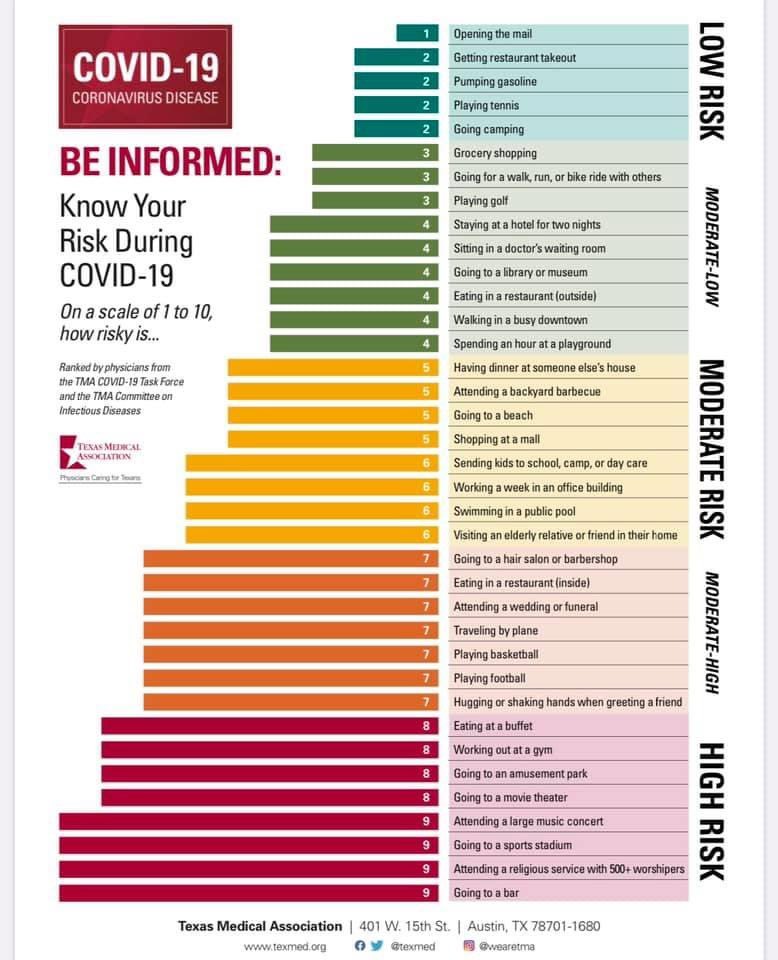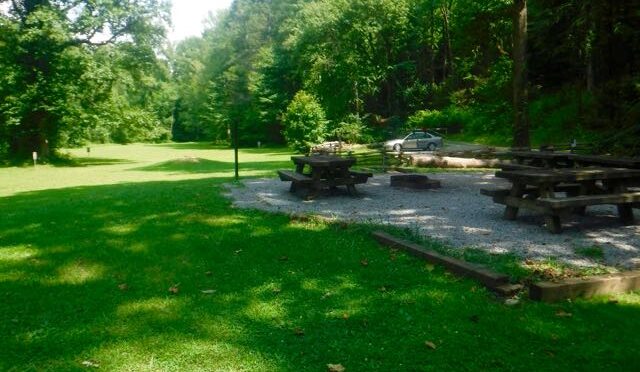If you haven’t seen it yet, there’s a graph from the Texas Medical Association circulating on social media that rates various activities from 1 to 10 based on their COVID-19 risk. Most risky (four are tied at 9): going to a bar, attending a religious service with 500+ worshippers, going to a sports stadium and going to a big music concert. Least risky: opening your mail (1).
But almost as safe as opening your mail, and a whole lot more fun: camping, which scores a 2.
 While being outside isn’t foolproof when it comes to avoiding the virus, its risk factor is pretty low, right down there with pumping gas and getting takeout. So for those of you whose summer vacation plans — be it a beach vacation (5) or flying (7) to an amusement park (8) — have been scrubbed, now may be the time to become a camper.
While being outside isn’t foolproof when it comes to avoiding the virus, its risk factor is pretty low, right down there with pumping gas and getting takeout. So for those of you whose summer vacation plans — be it a beach vacation (5) or flying (7) to an amusement park (8) — have been scrubbed, now may be the time to become a camper.
Why is camping considered lower risk? Three key reasons:
- You aren’t right on top of other campers. Most campgrounds — most good campgrounds — maintain a decent amount of space between individual campsites. Some of the more established mountain campsites have the additional advantage of being separated by rhododendron, mountain laurel and assorted trees. Those natural barriers deter visitors from wandering into your space.
- Most campgrounds are adjacent to other activities deemed safe. Going for a hike, a run or a bike ride (all 3s), for instance. Activities such as fishing and paddling weren’t included in the TMA analysis, but elsewhere they’ve been deemed low-risk outdoor activities.
- You’re self-contained. If you prepare well and take everything you need, from all of your food to your bedding to the nylon roof over your head, you have little contact with others. Never has there been more incentive to follow your packing list to the T, lest you find yourself having to visit the nearest Walmart.
The main drawback is that you likely will share a communal bathhouse. Campgrounds have stepped up their scheduled bathroom cleanings, but caution is urged all the same. Inquire when making your reservation how often the bathhouses are being cleaned, and consider bringing disinfectant wipes to do your own tidying up as well.
What to take
Here it comes, you’re thinking, the hefty price tag. Actually, no. Even if you’re starting from scratch, you likely already have most of the stuff you need to camp. In fact, there may only be two things you need to buy:
- Tent. You need a shelter, for protection from the elements, for privacy from your neighbors. Possibly you know a backpacker, who has casually mentioned that he dropped $500 for a tent — a one-person tent. In tent circles, what you pay for is weight, or rather, lack thereof. Your backpacking friend’s tent may just weigh a pound; that $500 investment is well worth it considering he may be carrying it on his back for tens, even hundreds of miles. When weight isn’t an issue, when you’re just carrying the tent 10 yards from your trunk to your tent site, you can score a roomy six-person tent for not much more than $100. That’s your main investment.
- Stove. The romantic in you may be saying, “I’ll just cook over an open fire.” The pragmatist (and your wife) is saying, “We want to eat. Get a stove.” The classic Coleman portable two-burner propane gas stove, which is easy to use, can be had for around $50. You can find one-burner stoves for about half that.
And everything else? You likely already have whatever else you need around the house, from old cookware you don’t mind getting more dented, to old blankets you don’t mind using in the woods, to your beach chairs. See Resources for more info.
What to eat
Whatever you eat at home! That’s part of the beauty of car camping. You’ve got a cooler with lots of ice, you’ve got a portable fridge (though not a freezer: ice cream, for instance, doesn’t keep its form for long in a cooler). Some things are preferred around the camp: hot dogs, for instance, grilled over an open fire (most campgrounds have a fire pit and sell seasoned (hopefully) firewood. Any kind of kabob food that needs grilling is good, frankly.
Where to go?
There are so many good places to car camp in North Carolina, especially in the mountains. Alas, we’re out of time and the space today to adequately address the issue. We’ll return Friday and share five of our favorite campgrounds in the state and why.
In the meantime, start working on that packing list!
* * *
Resource
Car Camping: A Guide to Suitable Substitutes. Our quick, easy-to-use packing guide lists the key pieces of equipment you’ll need to camp and the suitable substitute you likely already have at home. Available in our online store through Friday, July 10, for free using the code 6MHTAW5Y. Find the guide in our online library, here.
